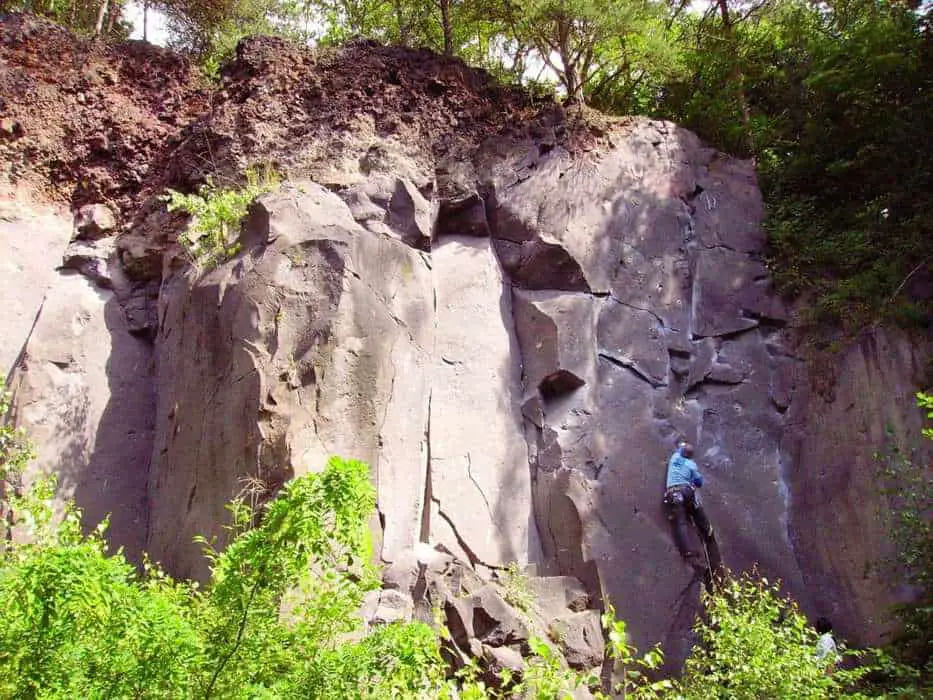
I was lying in bed one night thinking to myself, what would I have told myself to do or not do when I first started bouldering, or even a couple of months ago that would enhance my bouldering experience. After a while of mulling things over in my head and thinking about the lessons I’ve learnt in all my time climbing, I eventually typed out 16 tips on the notepad of my phone and went to sleep. These 16 tips are bouldering basics, what you should know when you go bouldering to help you have the best experience while you’re there and to show you what you need to do to quickly progress. I’ve thought about each of these tips more and realised there’s quite a bit of detail to add to each tip. To get the best bouldering experience possible you’ll have to at least be quite familiar with the bouldering basics.
So, what are the bouldering basics? The basics of bouldering are:
- Warm up/Cool down and stretch – Do this before you climb and afterwards.
- You should know your bouldering terrain – are you indoor or outdoor? What kinds of holds do you have to handle?
- Join in with a group of more advanced climbers – If you want to progress faster it’s better to learn from someone who’s better than you.
- Watch other people climb – If they’re better than you then watch them to check out the techniques they use.
- Use a hangboard (aka a fingerboard) – Using this just once a week will improve your finger strength massively.
- All climbers find their feet – If your feet aren’t on the wall it’s a lot harder. A lot of people neglect to use their feet in certain situations.
- Clench your foot like a monkey on slippery holds – This seriously helps to grip onto holds that have you slipping off.
- Don’t rush – You should think about your next move before you rush into it. Bouldering outdoors or in an indoor gym has no time limit so climb slowly if you can.
- Work on your strengths AND weaknesses – Don’t just advance on types of climbs you’re good at, work on your weaknesses too.
- Don’t get annoyed – If things don’t go your way don’t get annoyed because this will just make you climb worse.
- Safety first – Make sure you don’t endanger yourself or any others around you.
- Use the circuit board – Using the circuit board helps to improve your climbing technical ability, endurance and strength.
- Try bouldering outdoors – If you haven’t already tried it, outdoor bouldering is a really good experience.
- Get a good brush – A good brush for use on chalky holds is definitely needed.
- Find someone around your level and compete with them – By bringing in a competitive edge, you will want to get better faster and will push yourself.
- If you buy climbing shoes, make sure they suit your needs – Buying the wrong climbing shoes is a waste of money.
Click on any of the links in the list below to jump to a more detailed overview of that tip. I go into detail about each of these tips below. Keep reading if you want to find out more.
Page Jumps
- Warm up/Cool down and stretch
- You should know your bouldering terrain
- Join in with a group of more advanced climbers
- Watch other people climb
- Use a hangboard
- All climbers find their feet
- Clench your foot like a monkey on slippery holds
- Don’t rush
- Work on your strengths AND weaknesses
- Don’t get annoyed
- Safety first
- Use the circuit board
- Try bouldering outdoors
- Get a good brush
- Find someone around your level and compete with them
- If you buy climbing shoes, make sure they suit your needs
1. Warm up/Cool Down and Stretch
It’s probably not a surprise to most of you when you find out that warming up and cooling down (especially warming up) are vital parts of your climbing session. For me, a climbing session can be completely ruined by even the smallest of injuries. Imagine snapping a tendon in your finger from having stiff hands because you hadn’t warmed up properly – not only would your climbing session be ruined, healing the injury requires that you do not climb (or do any other activity involving that finger) for around 3-6 months. It is imperative that you warm up your muscles before you start your climbing session.
Warming up can be done in a few different ways: by doing physical activity and stretching in the gym area, or you can climb lower grades, slowly, with 100% proper technique. As rock climbing is a full body workout, try to involve your whole body in your warm up and stretching routine; however the main muscles used are the back muscles, finger/forearm muscles, and the core.
Cooling down is also quite vital as it has been proposed that it benefits you by:
- Cooling your body temperature after a warm, sweaty session
- Bring your heart rate back to normal
- Relaxing your muscles so they can heal faster
- Bringing your breathing rate back to normal
- Returning the body to homeostasis
2. You Should Know Your Bouldering Terrain
If an army is going into battle, the strategists on each side will want to know as much about the other army as possible. So when you’re climbing you should want to know more about the terrain you’re climbing and the types of holds you’re using before you step on the wall.
First of all, is it indoor or outdoor? If you’re climbing outside then you’ll need to think about the weather – how hot or cold is it, and what will you need to while you’re there? The type of rock you’re climbing is also a big factor – is the rock made of limestone, granite, sandstone, basalt, or quartzite?
If you’re climbing inside and you’re about to start something that’s difficult for you, then you should check out the types of holds you’ll be using in the climb. Are they all slopers, or is there a nice big jug for you to hang on to?
3. Join in with a Group of More Advanced Climbers
This is definitely something I recommend. When I first started climbing I joined in with a group of people that had been climbing for years. I did this by being friendly at first, plus I enjoyed climbing with them. I progressed so fast!
By joining in with a group of people who are more advanced climbers than you, you pay more attention to the techniques they use as they climb up the wall which helps you learn. You can also ask them for help you with your climb if you’re stuck which may give you a chance to learn some new techniques if they decide to show you how to do the climb. As you pick up these techniques faster, you’ll get better a lot faster.
4. Watch Other People Climb
When you watch other people climb it helps you to understand why they did a certain technique at one point and succeeded or what made them fail and fall off the wall. Most of the time you should be watching more advanced climbers and learn to mirror their movements when it comes to your time on the wall. Take note of how they use weight distribution or what technique they use to transition from one part of the wall to another; foot swaps, sagging, and dynamic movements are all advanced techniques that you can learn from watching better climbers.
5. Use a Hangboard (aka a Fingerboard)
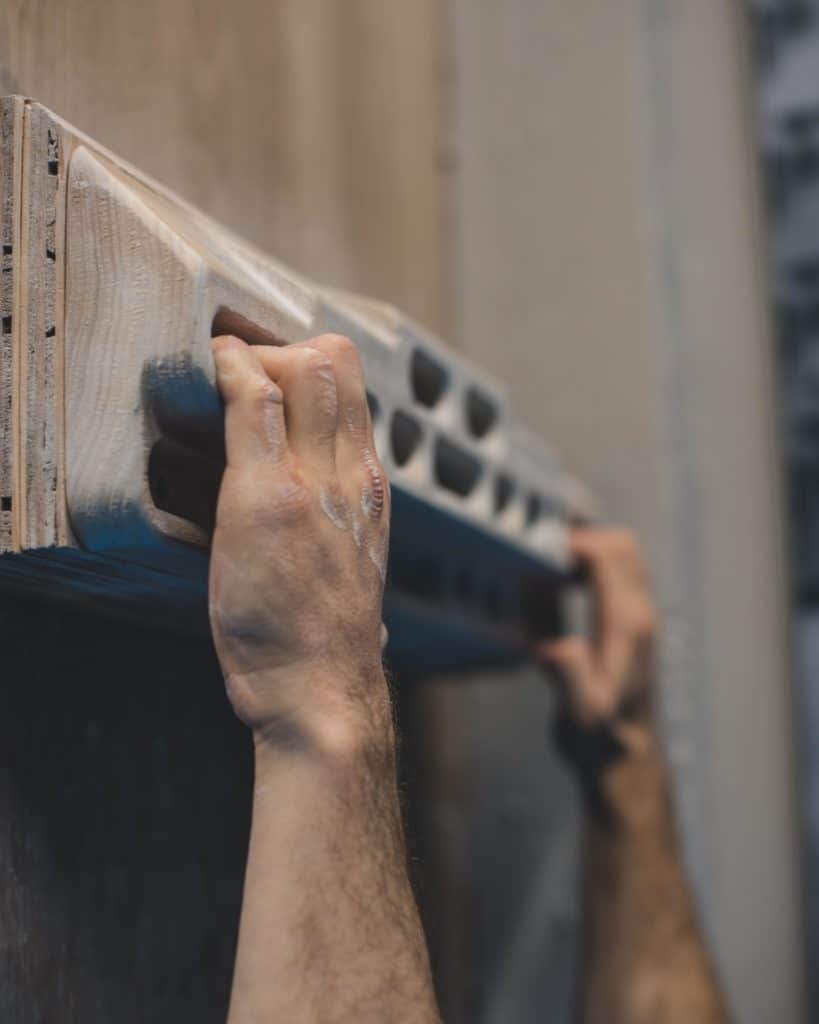
One of the main muscles groups used in climbing are your forearms and fingers. You’ll need to have really good grip strength if you want to be able to climb well, and it just so happens that your fingers can become so strong over time that you may eventually be able to do a 1 finger pull up… but to do that you have to practice!
Using a hangboard, which is also known as a fingerboard, will help to increase your grip strength and therefore increase your climbing ability. If you’re ever injured and you don’t want to lose your grip strength, [if hangboards don’t affect your injury] they provide a great way to not only keep yourself from losing strength in your fingers but also gain it while you recover. You can buy hangboards to use at home, and you can find my recommended hangboards at this link.
6. All Climbers Find their Feet
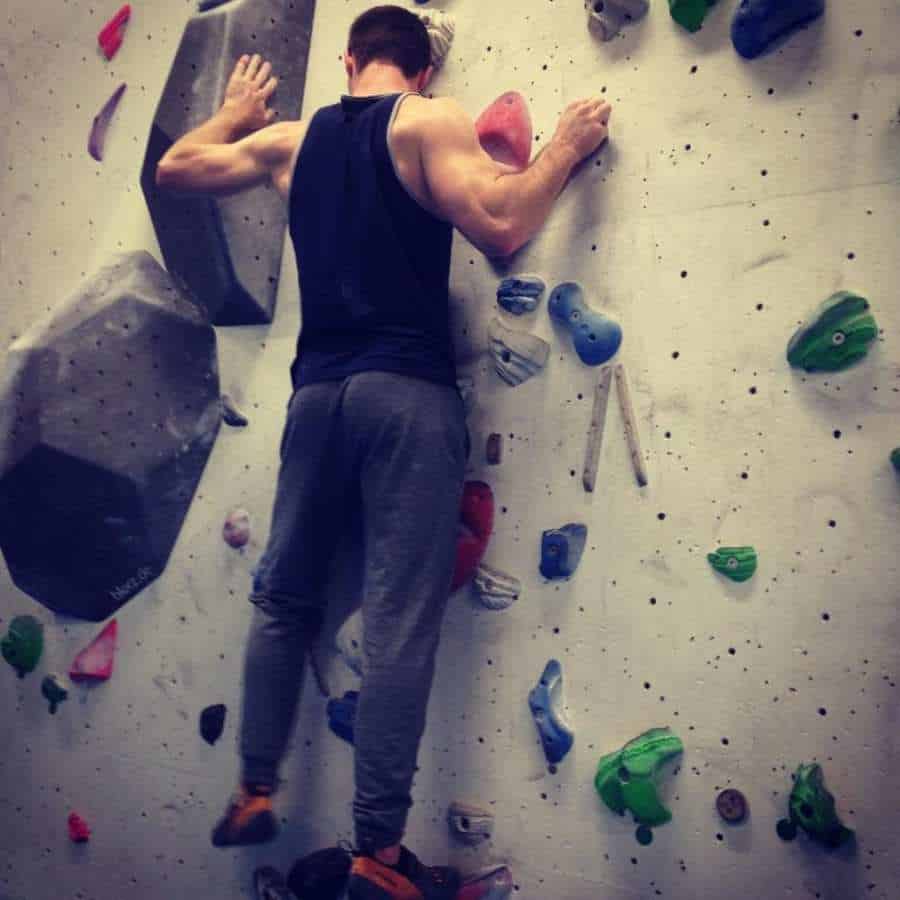
It’s now a rule of mine to always focus on my foot position before I attempt to move onto another part of the wall. Some climbers are surprised when they find out that your foot position means so much. If you’re struggling on a climb, it may be because you haven’t used a foot hold or you haven’t used it correctly – you may need to use a heel hook rather than a toe. It’s pretty simple really, find your feet and it’ll help you advance much more quickly.
7. Clench Your Foot Like a Monkey On Slippery Holds
This is one tip I wish I’d have learnt sooner. Have you ever had trouble starting a climb because the toe hold is too slippery? This is quite common and COULD be fixed with one simple trick: clench your toes like a monkey does when they climb. Use your foot as if it were a hand trying to grab onto the foot hold below. On smaller foot holds this may not work; however on bigger, slippery holds this may be the perfect technique that helps you start the climb. Ever better it may help you end a tricky one.
8. Don’t Rush the Climb
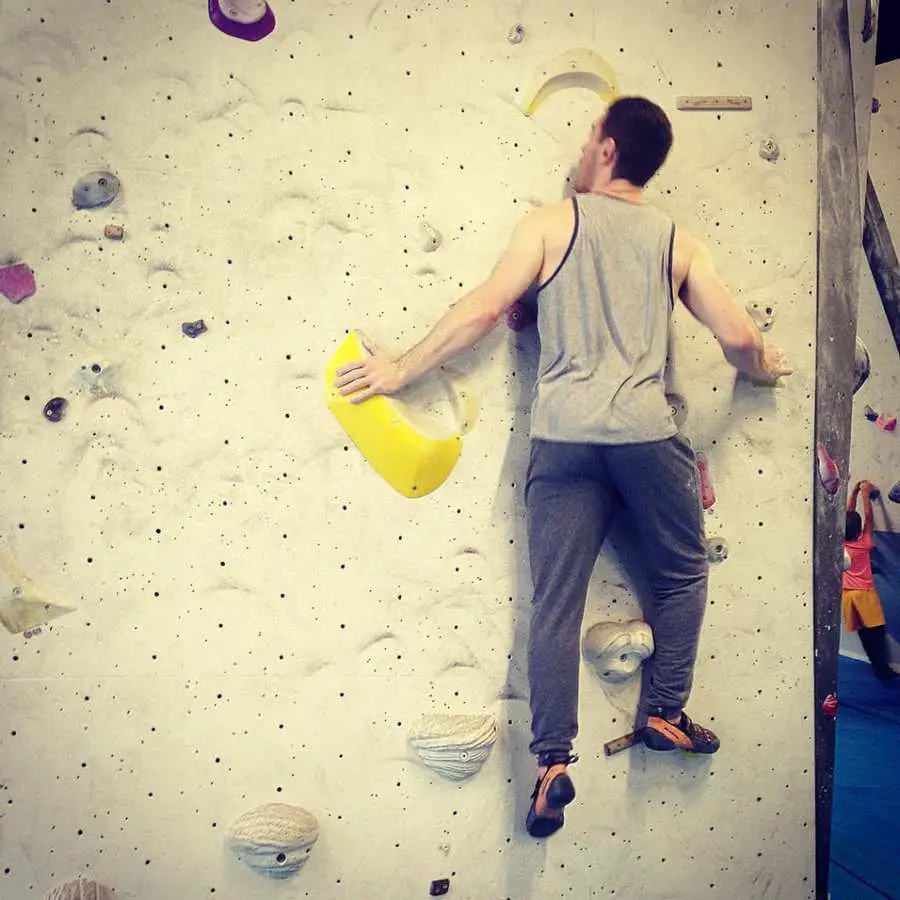
One of my the main problems I had when I first started climbing (and even for a few months after) was how aggressive I was on every climb that I tried, mainly because I wanted to get through it as fast as possible and finish it. This was especially true if I was stuck on a particular part and wanted to get it done.
Rushing a climb can result in injuries due to tension in muscles and overall lack of control. For the most part, climbing is about control of your current position and the transition thereafter. When you rush a climb, you aren’t usually in control of your body. You also burn out a lot quicker because your muscles are working too hard, too fast. If you’re rushing a climb then you aren’t focusing on your technique and therefore you aren’t going to progress as fast. It is paramount that you focus on using proper technique if you wish to advance onto higher grades. It is detrimental to your climbing ability if you climb too aggressively and/or too quickly.
9. Work on Your Strengths AND Weaknesses
Personally, I’m really bad at overhangs. However, vertical climbs and slabs seem to be where I shine. Whenever there’s a high grade climb that’s just been set out on a slab or a vertical wall that I know I’m good at, I’ll go for it and a lot of the time I’ll succeed. This is how I progress in my strengths. However, a lot of people seem to only climb their strengths because they want that sense of accomplishment they get when they complete a high grade climb.
I try to work in at least one climb per session on an overhang because I know I’m not good at them. I don’t climb something that’s easy and takes hardly any effort – I climb an overhang that’s a lower grade than the slabs I can climb, however it has to give me a bit of trouble. I want to better my technical skills on overhangs (my weakness) and the best way to do this is by climbing an overhang that gives me a little bit of grief.
10. Don’t Get Annoyed
Having a positive mindset about the wall in front of you really is a big deal when it comes to climbing. If you start becoming negative about a certain position or transition on a climb, take yourself away from it and try something else. Don’t let it ruin your session – climbing is a recreational sport practiced for fun and getting annoyed won’t help you progress in any way nor will you finish your session in a happy mood.
11. Safety First
You should cause as little danger to yourself and other climbers as possible. There are a few simple rules you should follow to be as safe as possible when you’re bouldering. Following these rules will not only decrease the risk of you endangering yourself or others, but it will also improve your climbing etiquette. The rules are:
- Learn how to fall: push yourself away from the wall, engage your neck muscles, land on your feet and bend your knees, roll back. For more information on this click this link.
- The climber already on the wall has priority, don’t climb under them when they’ve already started climbing.
- Stay alert of what’s happening close to and above you. People could be climbing above you without your knowledge if you aren’t paying attention.
- Any equipment (chalk bags, brushes, bottles) left in an area where a climber (such as yourself) may fall should be moved to decrease risk of injury.
- Climb down the bouldering wall after you’ve completed a climb, don’t jump from quite a height. Every time you jump, no matter which way you land, you’re affecting the vertebrae in your spine. Don’t like bad backs? Then climb down whenever possible.
12. Use the Circuit Board
Bouldering on the circuit board is a fantastic way to improve your technical skills, your forearm and finger strength, and your overall climbing endurance. This is one trick I missed until recently. I’ve found it really helps your overall climbing ability when you use the circuit board and I wish I’d have found it earlier.
13. Try Bouldering Outdoors
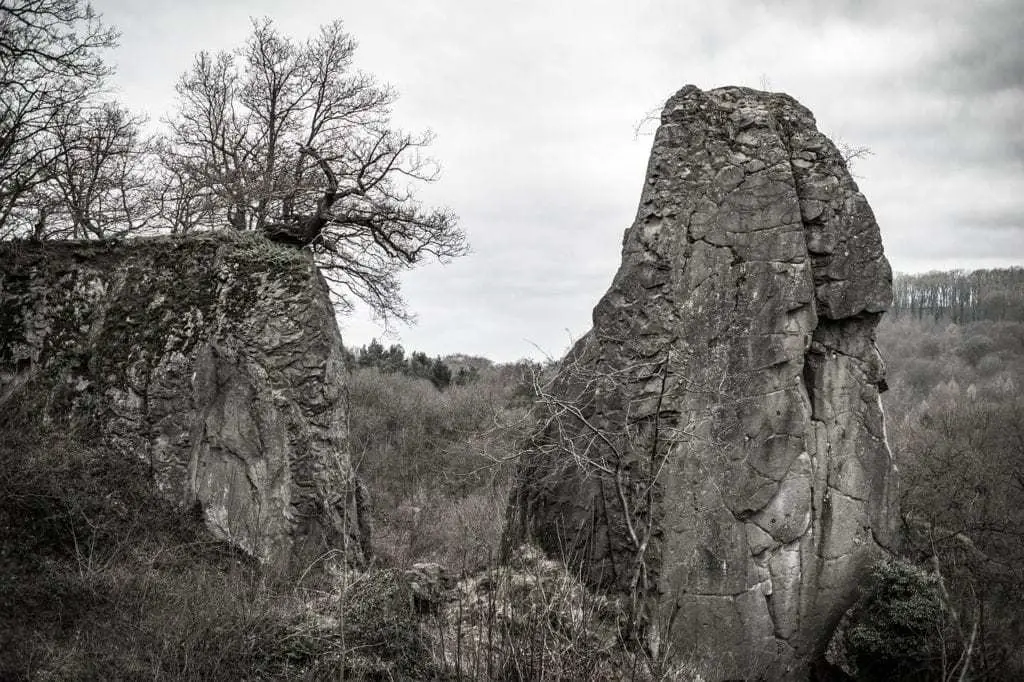
Bouldering outdoors gives you a new perspective on bouldering or even climbing as a whole. It’s just so much more peaceful. It’s climbing in a real life environment rather than an artificial wall with holds attached that have been set up by a person. Bouldering in nature not only gives you a real life climbing feel, but it’s also very calming. The holds feel a lot different to the plastic ones you find at indoor gyms. You can also make it a social activity by including a few friends on your trip. If you’re considering outdoor bouldering on your own, you can check out my article on solo bouldering by clicking here.
14. Get a Good Brush
I must have used a toothbrush to clean all my climbing holds until around 6 months into my climbing career. Once I actually bought a brush that could sufficiently clean hand holds of excess chalk, I was pleasantly surprised at how much of a difference it makes. They really aren’t much money so you should probably invest in one as they are worth it. Check this link for the Sublime Slimline Climbing Brush which is perfect for cleaning bouldering holds.
15. Find Someone around Your Level and Compete with them
Me and my friend Dan go climbing together once a week and we’re around about the same climbing level, some would say I’m even better… ha! We started climbing near enough at the same time as each other. Whenever we train with each other we want the other person to do their best and improve, but we also want our own ability to improve as well. To do this we know that a great method is to compete with each other while helping each other. We want the other person to do well because it means WE have to do well. This makes us a better climber! We try harder! The better the other one is, the better we have to become. It’s something I would highly recommend trying out.
16. If you Buy Climbing Shoes, Make Sure they Suit your Needs
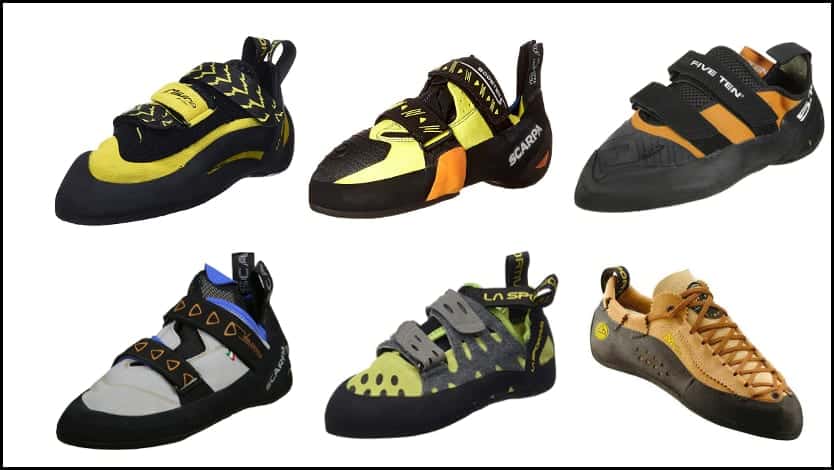
Some people buy climbing shoes that are completely wrong for their type of climbing. Some climbing shoes are made for specific reasons, however I know a few people who buy climbing shoes without even considering what the shoe does. They’ll buy slip-on shoes or ones with Velcro straps when they would probably have been better offer with laces; or they’ll buy La Sportiva Miuras when they would have been more suited to Scarpa Instincts or Scarpa Booster S climbing shoes. The truth is, buying a pair of climbing shoes depends on how you climb, what you climb and what type of climbing you’re doing. If you only boulder you’ll want a bouldering shoe like the Scarpa Instinct, but if you want versatility because you lead climb and boulder then you’ll want the La Sportiva Miura. Check this article out that I wrote to read up on my personal opinion regarding the best climbing shoes for versatility, bouldering, when you’re on a budget, sport climbing, beginners, and comfort.
